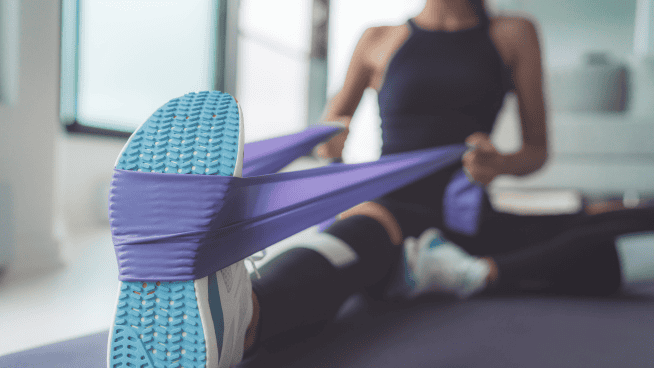Decoding Your Body Signals: Fast Track to Recovery and Prevention
Workouts aren’t supposed to be easy. As an athlete, you push yourself way past your comfort zone. You train through sore muscles, even when you don’t feel like it, just so you can reach your next goal. (See Training ‘Til You Puke: A Sign of Hard Work or Incorrect Training?)
To avoid injury, everyone tells you to listen for your body’s signals. But listening to your body is difficult. How can you tell the difference between discomfort and serious pain?
The goal of any training is to push your body to the limit, but not beyond. Again, easier said than done. But you can do it. Use the following tips to gauge your body signals to decide when you should rest, push through or slow down. (Watch Olympian Dathan Ritzenhein on Knowing Your Limits.)
Body Signals During Training
Use the Pain Rating Scale
According to a University of Heidelberg study, athletes have a higher tolerance for pain than the average person. One theory is that endorphins produced during high intensity workouts mask the seriousness of the pain.
The first assessment in any rehab program is to learn to rate pain’s intensity. Learning your own personal ranking scale is the most effective way for you to monitor your pain. Be prepared to rank your pain on a scale from zero to 10 (10 as the worst pain you’ve ever experienced and zero being no pain at all). According to the BORG RPE (Rating of Perceived Exertion), your workout should not go above a seven (very hard).
Identify the Type of Pain
There are two different types of pain you may experience.
Acute pain: Also known as cause and effect pain. This is sharp pain associated with an injury, event or trauma. It is easily diagnosed and treatable, like if you sprain your ankle.
Chronic pain: This pain is hard to diagnose and even harder to remedy. It’s best defined by longevity and resistance to therapy. For an athlete, chronic pain can present itself as a symptom of an overuse injury, a biomechanical abnormality, an anatomical imbalance or a result of psychosocial (beliefs and attitudes) conditioning.
Diversify Your Workouts
Find new endorphin-rich alternatives to the “no pain, no gain” mentality through cross training. The April 2013 edition of Orthopedics This Week found that youth athletes who participated in multiple sports suffered fewer injuries than those who specialized.
Body Signals During Rehab
Let’s face it though. It’s hard to monitor pain when you’re constantly pushing yourself to the brink. Unfortunately, at some point, most competitive athletes suffer an injury and subsequently find themselves in rehab. Once in rehab, it becomes even more important to listen to your body. Here’s what you need to do.
Take Your Homework Seriously
Your therapist will assign you homework throughout rehab for two reasons: to determine if the diagnosis is correct and if the regimen is working. How seriously you take this homework plays a huge role in how quickly you rehabilitate.
With each of the assigned exercises, take note of your pain and its characteristics. Get away from the adage of “no pain, no gain,” and start listening to what your body is telling you. Don’t push past three on the pain scale, unless your rehab program involves exercises to break up scar tissue (e.g., during recovery from a rotator cuff injury), in which case your therapist may allow a higher pain rating.
It’s also important to pay attention to how you feel after a therapy session or homework. Note how long it takes your body to recover from the discomfort. You may have experienced a fairly high pain scale, but a few hours later you feel remarkably better—or the exact opposite. Always report these feelings back to your therapist.
Breathing
A 2010 University of Arizona study found slow, meditative breathing can reduce a person’s perception of pain. Sign up for a meditation class and practice your breathing. (Read Breathing Techniques to Improve Recovery.)
Stay Active
Rehab drastically alters your usual workout schedule, suppressing your habitual endorphin high. Ask your therapist for alternative and safe workouts to continue training your body. Rehabbing an ankle shouldn’t stop you from challenging your healthy upper body.
Measure Your Progress
Measure your rehab progress just as intently as you do your athletic progress. Keep a journal to track pain perception and intensity. Always share this with your therapist.
Returning to Normal
Once you’ve been given the green light to resume normal activity, think moderation. Begin with easy workouts, always paying attention to how you feel and your recovery. Pay attention to your pain scale and avoid workouts that push you past the middle of the scale. Extend your workouts only when you feel no acute pain.
Also, use breathing to increase your endurance and maximize positive emotions, which are essential to keep pain at a manageable level. Continue to journal your workouts, and notice which workouts feel better and which push you toward the injury zone.
If chronic pain occurs, see a specialist and look at biomechanics, muscle imbalance or the potential of an overuse injury. When it comes to signals from the body, listening might be your best route to longevity as an athlete.
RECOMMENDED FOR YOU
MOST POPULAR
Decoding Your Body Signals: Fast Track to Recovery and Prevention
Workouts aren’t supposed to be easy. As an athlete, you push yourself way past your comfort zone. You train through sore muscles, even when you don’t feel like it, just so you can reach your next goal. (See Training ‘Til You Puke: A Sign of Hard Work or Incorrect Training?)
To avoid injury, everyone tells you to listen for your body’s signals. But listening to your body is difficult. How can you tell the difference between discomfort and serious pain?
The goal of any training is to push your body to the limit, but not beyond. Again, easier said than done. But you can do it. Use the following tips to gauge your body signals to decide when you should rest, push through or slow down. (Watch Olympian Dathan Ritzenhein on Knowing Your Limits.)
Body Signals During Training
Use the Pain Rating Scale
According to a University of Heidelberg study, athletes have a higher tolerance for pain than the average person. One theory is that endorphins produced during high intensity workouts mask the seriousness of the pain.
The first assessment in any rehab program is to learn to rate pain’s intensity. Learning your own personal ranking scale is the most effective way for you to monitor your pain. Be prepared to rank your pain on a scale from zero to 10 (10 as the worst pain you’ve ever experienced and zero being no pain at all). According to the BORG RPE (Rating of Perceived Exertion), your workout should not go above a seven (very hard).
Identify the Type of Pain
There are two different types of pain you may experience.
Acute pain: Also known as cause and effect pain. This is sharp pain associated with an injury, event or trauma. It is easily diagnosed and treatable, like if you sprain your ankle.
Chronic pain: This pain is hard to diagnose and even harder to remedy. It’s best defined by longevity and resistance to therapy. For an athlete, chronic pain can present itself as a symptom of an overuse injury, a biomechanical abnormality, an anatomical imbalance or a result of psychosocial (beliefs and attitudes) conditioning.
Diversify Your Workouts
Find new endorphin-rich alternatives to the “no pain, no gain” mentality through cross training. The April 2013 edition of Orthopedics This Week found that youth athletes who participated in multiple sports suffered fewer injuries than those who specialized.
Body Signals During Rehab
Let’s face it though. It’s hard to monitor pain when you’re constantly pushing yourself to the brink. Unfortunately, at some point, most competitive athletes suffer an injury and subsequently find themselves in rehab. Once in rehab, it becomes even more important to listen to your body. Here’s what you need to do.
Take Your Homework Seriously
Your therapist will assign you homework throughout rehab for two reasons: to determine if the diagnosis is correct and if the regimen is working. How seriously you take this homework plays a huge role in how quickly you rehabilitate.
With each of the assigned exercises, take note of your pain and its characteristics. Get away from the adage of “no pain, no gain,” and start listening to what your body is telling you. Don’t push past three on the pain scale, unless your rehab program involves exercises to break up scar tissue (e.g., during recovery from a rotator cuff injury), in which case your therapist may allow a higher pain rating.
It’s also important to pay attention to how you feel after a therapy session or homework. Note how long it takes your body to recover from the discomfort. You may have experienced a fairly high pain scale, but a few hours later you feel remarkably better—or the exact opposite. Always report these feelings back to your therapist.
Breathing
A 2010 University of Arizona study found slow, meditative breathing can reduce a person’s perception of pain. Sign up for a meditation class and practice your breathing. (Read Breathing Techniques to Improve Recovery.)
Stay Active
Rehab drastically alters your usual workout schedule, suppressing your habitual endorphin high. Ask your therapist for alternative and safe workouts to continue training your body. Rehabbing an ankle shouldn’t stop you from challenging your healthy upper body.
Measure Your Progress
Measure your rehab progress just as intently as you do your athletic progress. Keep a journal to track pain perception and intensity. Always share this with your therapist.
Returning to Normal
Once you’ve been given the green light to resume normal activity, think moderation. Begin with easy workouts, always paying attention to how you feel and your recovery. Pay attention to your pain scale and avoid workouts that push you past the middle of the scale. Extend your workouts only when you feel no acute pain.
Also, use breathing to increase your endurance and maximize positive emotions, which are essential to keep pain at a manageable level. Continue to journal your workouts, and notice which workouts feel better and which push you toward the injury zone.
If chronic pain occurs, see a specialist and look at biomechanics, muscle imbalance or the potential of an overuse injury. When it comes to signals from the body, listening might be your best route to longevity as an athlete.











